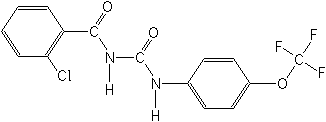|
Return
to Index Page
Activity: Insecticide
(Benzoylurea)
Structure:

Adverse
Effects:
Blood
Environmental
•
As of October 2003 - No toxicological information available.
• 10 of the 11
benzoylurea insecticides cited in this article are organofluorines
(highligted in red).
"Benzoylureas
are an entirely different class of insecticides that
act as insect growth regulators (IGRs). Rather than
being the typical poisons that attack the insect nervous
system, they interfere with chitin synthesis and are taken
up more by ingestion than by contact. Their greatest value
is in the control of caterpillars and beetle larvae. Benzoylureas
were first used in Central America in 1985, to control a
severe, resistant leafworm complex (Spodoptera spp., Trichoplusia
spp.) outbreak in cotton. The withdrawal of the ovicide
chlordimeform made their control quite difficult due to
their high reistance to almost all insecticide classes,
including the pyrethroids. The first
benzoylureas were introduced in 1978 by Bayer of Germany,
triflumuron (Alsystin(r)) being
the first. Others
appearing since then are chlorfluazuron
(Atabron(r), Helix(r)), followed by
teflubenzuron (Nomolt(r),
Dart(r)), hexaflumuron
(Trueno(r), Consult(r)), flufenoxuron
(Cascade(r)), and flucycloxuron
(Andalin(r)). Others are flurazuron,
novaluron, and diafenthiuron.
Lufenuron (Axor(r))
is the newest addition to this group, appearing in 1990.
Surprisingly, none of these are registered in the U.S. The
only benzoylurea registered in the U.S. is diflubenzuron
(Figure 21) (Dimilin(r), Adept(r), Micromite(r))...
Ref: An
Introduction to Herbicides (3rd
edition) by George W. Ware
|
| |
| - |
Organo-
phosphates
|
Synthetic
pyrethroids |
Cyromazine |
Dicyclanil |
Diflubenzuron |
Triflumuron |
| 1992-93 |
10.2 |
5.8 |
- |
- |
- |
- |
| 1993-94 |
9.0 |
6.6 |
- |
- |
- |
- |
| 1994-95 |
4.3 |
5.7 |
5.2 |
- |
- |
- |
| 1995-96 |
4.4 |
5.5 |
6.3 |
- |
- |
- |
| 1996-97 |
4.5 |
3.8 |
8.7 |
- |
1.2 |
3.5 |
| 1997-98 |
5.8 |
3.3 |
5.8 |
- |
3.6 |
6.1 |
| 1998-99 |
2.4 |
1.6 |
7.4 |
- |
3.5 |
7.6 |
| 1999-00 |
2.2 |
2.0 |
5.1 |
0.1 |
2.9 |
9.0 |
| Source:
Woolmark Company |
Blood
(click
on for all fluorinated pesticides)
Abstract: The effects of five benzoylphenylurea insecticides,
diflubenzuron (35367385), flufenoxuron (101463698), hexaflumuron
(86479063), teflubenzuron (83121180), and triflumuron
(64628440) were comparatively evaluated on hematological
parameters in rats. Sixty adult Wistar-rats were divided into
five dose groups and a control group. Daily doses of 100mg/kg
of each tested insecticide were administered by gavage for 28
days, after which rats were sacrificed and blood was taken for
examination. Parameters measured were red blood cell count, hemoglobin
(Hb), hematocrit, mean corpuscular volume, mean corpuscular Hb
concentration, methemoglobin (metHb), and reticulocyte counts.
Results showed that treatment with insecticides at the dose given
did not produce any overt signs of toxicity. However, with regard
to hematological parameters, both diflubenzuron and triflumuron
induced elevated metHb levels. The no observed effect level for
metHb was 45mg/kg. The reticulocyte level was increased in all
treated groups, even at dose levels of 50mg/kg. The authors conclude
that the metHb level increase and reticulocyte increase are the
most sensitive parameters, but that one might be independent of
the other.
Ref: 1993. J Appl Toxicol; Jan-Feb;13(1):67-8.
Comparative
study on the effects of five benzoylphenylurea insecticides on
haematological parameters in rats, by Tasheva M, Hristeva
V.
|
Environmental
(click
on for all fluorinated pesticides)
Triflumuron
is very toxic to aquatic organisms. Triflumuron is toxic
to bees.
Triflumuron: Fish
toxicity:
LC50 (96 hr) bluegill sunfish (Lepomis macrochirus) >
20.8 µg/L
LC50 (96 h) rainbow trout (onchorhynchus mykiss) > 24.2
µg/L
Triflumuron: Daphnia
toxicity:
EC50 (48 h) water flea (Daphnia magna) 1.6 µg/L
Triflumuron: Algal
toxicity:
Growth rate: IC50 (72 h) green algae (Desmodesmus subspicatus)
> 0.025 mg/L
Ref: August 9, 2004. Material
Safety Data Sheet for Alsystin 250 Larvicide. Bayer
CropScience.
Triflumuron
is a toxic hazard to juvenile aquatic and terrestrial arthropods
Fish
toxicity:
LC50: > 10 mg/L (96 h) rainbow trout
LC50: >100 mg/L (96 hours) golden orfe
Daphnia toxicity:
EC50: 0.23 mg/L (48 hours) daphnia magna.
Environmental
fate, persistence and degradation:
Degradation of active constituent - half life:
t l/2: 960 days at pH4 (22 0 C)
t l/2: 580 days at pH7 (22 0 C)
tl/2: 11 days at pH9 (22 0 C)
Ref:
Material
Safety Data Sheet for Intrigue Termite Dust. Supplier:
Bayer Environmental Science Ð A Business Group of Bayer
CropScience Pty Ltd ABN 87 000 226 022 Address: 391 - 393
Tooronga Road, East Hawthorn Victoria 3123, Australia
http://www.fluorideaction.org/pesticides/triflumuron.msds.bayer.02.pdf
|
|